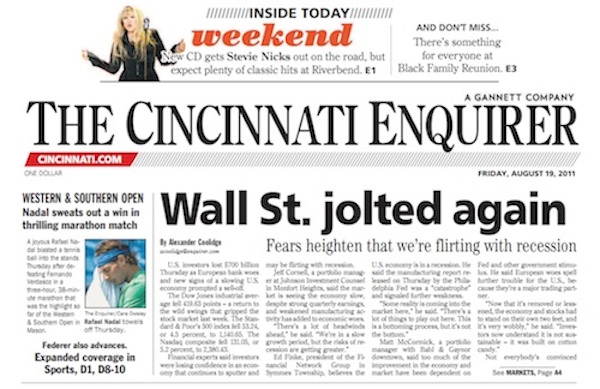
For newspapers, rolling the dice doesn’t always involve paywalls. Take The Cincinnati Enquirer and The Columbus Dispatch, both of which recently announced plans to switch their printing formats from classic broadsheet to a new compact style more akin to a tabloid, but with sections similar to a traditional paper.
That might seem like a small change; it’s not. Leaping from a format you’ve published in for more than a century is a dramatic step. And it’s emblematic of a new willingness among newspapers to take risks with their most precious assets — which are typically, in financial terms, still their print products.
Under the terms of an agreement between the two papers, the family-owned Dispatch will begin printing the Gannett-owned Cincinnati Enquirer (as well as its northern Kentucky edition, The Kentucky Enquirer) next fall, with The Dispatch going compact in 2013. The Enquirer’s shift in paper size — the new version will measure 10 1/4″ x 14 1/2″ — is, unsurprisingly, about economics: Gannett has been looking to gain efficiencies largely by way of reduction. Having already cut staff through layoffs and reduced jobs through centralizing design, the company, with the two papers, is also outsourcing printing and literally shrinking the size of its product.
Both The Dispatch and The Enquirer say the move is about serving the needs and habits of their readers. Margaret Buchanan, president and publisher of The Enquirer, told me reader response to print prototypes indicated that the audience wanted their newspaper to change. “We conducted focus groups with existing loyal readers,” she said. “We were concerned that if our loyal readers wouldn’t like this format, it probably wouldn’t be in our best interest.”
But she said those focus groups wanted a paper that was, all in all, “easier” — easier to fit into briefcases or laptop bags, easier to read on a table at breakfast, or easier to keep together in one piece. Their testing made clear, Buchanan said, that people want a paper that is “more adaptable.”
Advertisers were, of course, the other test segment that had a chance to look at a compact mock-up of The Enquirer. A new format means new ad possibilities, more modular units for advertising, and, Buchanan said, more color. It also presents a new unique challenge for the paper’s designers and artists, who will be redesigning the paper almost from the ground up: “From the content side, I think it will really challenge us to utilize photos and graphics in ways we maybe haven’t done in a broadsheet,” she said.
The show model was a hit with The Enquirer’s focus groups (which Buchanan noted were all 7-day subscribers over the age of 45), so much so that an interesting question arose from the test: “In some cases, people asked why we didn’t do this years ago,” Buchanan said. Why not, indeed? Buchanan told me that they’ve been working on a smaller model of the newspaper for at least 3 years. In many non-U.S. newspaper markets, notably the U.K., many broadsheets have made the switch to smaller formats in the past decade.
Now, though, newspapers — and mid-size dailies, in particular — are in full-on adapt-to-survive mode. And part of that means recognizing changes in their audiences. Traditionally a smaller, tabloid-esque paper was thought to be a good match for dense urban areas with public transportation and exceedingly, er, mobile readers: They take the paper with them on the bus or the subway, or just to have during a quick morning coffee or lunch. A smaller format offers print’s promise of a contained reading/news experience, while also packing in plenty of graphics and photos. Think about the other outlet for smaller-format papers: the alternative press, which also uses its size as selling point to a young (and again) mobile audience.
Cincinnati and Columbus are not New York and Chicago. But Buchanan believes her paper will hold value with its existing readers and potentially help to bring in a new audience. “I see it as an opportunity to attract younger readers because of the compact nature of it and the visual aspects of it,” she said.